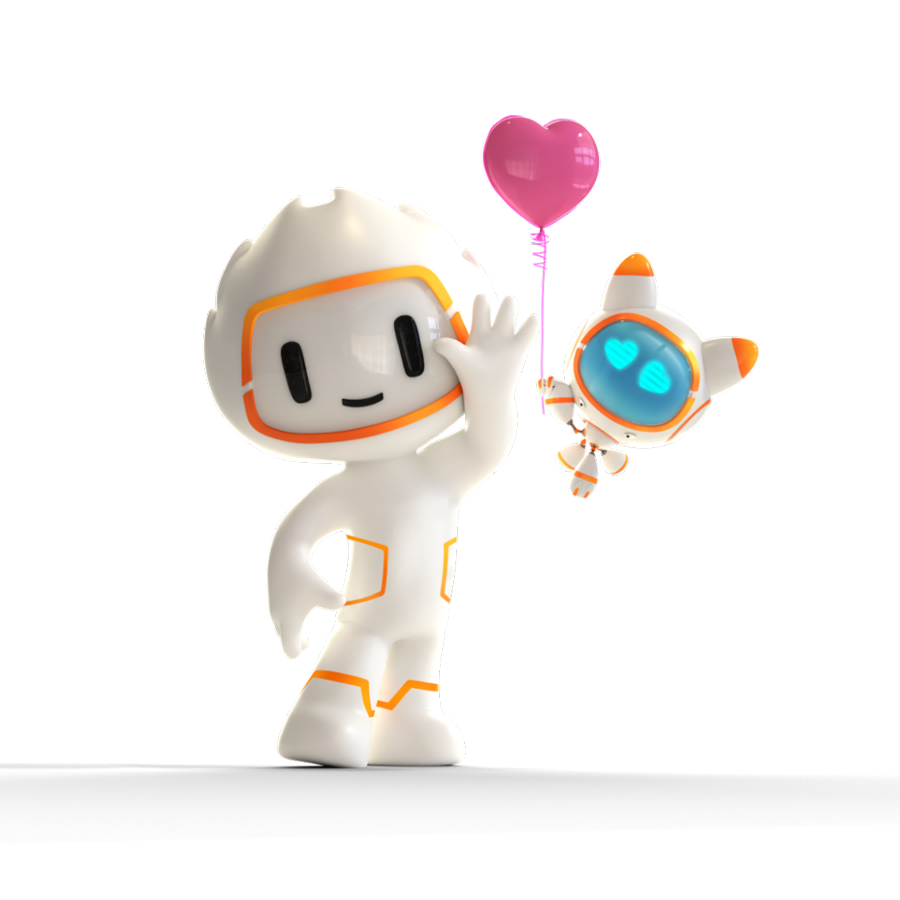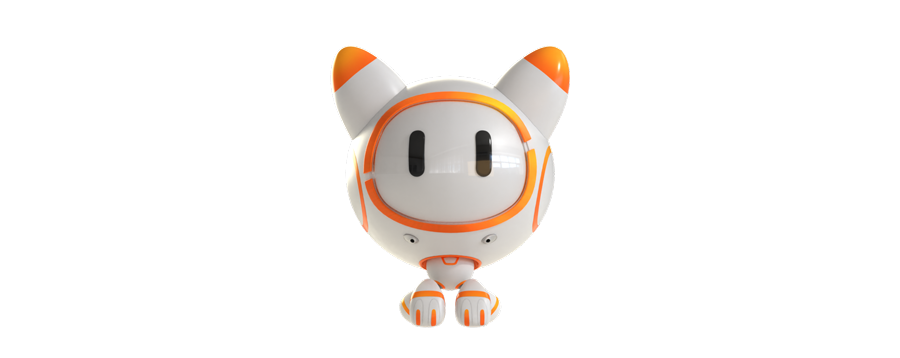
It’s no surprise that if you ask any business what their ultimate goal is in branding, the first thing they’ll say is, “We want to stand out!” Or maybe, “We want to be better!” They might even mention a couple of big competitors in their industry and say, “We want to beat them, and we want people to choose us instead!”
Fair enough. We get it.
Now, there are countless ways to achieve that, and we’ve all heard the options. When it comes to branding, we’ve seen lots of creative approaches out there, but there’s one that has literally been around forever—unique, yet often overlooked, especially in the B2B space—and that’s using a B2B brand mascot, or more commonly known as a brand character. It could be a person, an animal, an object, or something entirely made up.
Read more about the brand mascot meaning …
Think about it—some mascots come to mind even faster than the brand itself, its logo, or even its color scheme. So why is it that B2B brands often say ‘no’ to this idea when there’s such huge potential?
In this article, we’re going to take a closer look at that question. Is this ‘no’ actually justified, or is it time for B2B brands to reconsider and embrace the power of B2B mascots?
Let’s dive in and find out.
Before We Start, Let the Data Speak
Even though the use of mascots has dropped a lot in advertising over the past 20 years, the numbers show they’re actually becoming more effective. According to research from System1, while the use of mascots in U.S. ads has fallen from 41% in 1992 to just 4% today, campaigns that do use mascots are 37% more likely to grow their market share, 27% more likely to gain new customers, and 30% more likely to boost profits.
Wait, it gets even better.
Long-term campaigns featuring mascots can bring even more significant results.
A study by Technicolor Studio found that these campaigns can increase profits by 34.1%. Plus, mascots don’t just drive sales—they help brands form stronger emotional connections with their customers, increasing engagement and loyalty by as much as 41%.
Well, that’s HUGE for brands looking to grow.
What else?
These days, ads are like the air we breathe, so let’s not forget about them.
Characters also help brands stand out more effectively by increasing ad viewability, extending dwell time by up to 50%, and improving spontaneous brand recall by 25%.
Research shows that characters offer a unique advantage in digital campaigns, where emotional impact is critical for brand recognition. Ads with mascots are more likely to be remembered and engage audiences, creating long-term brand equity.
So, while fewer brands may be using mascots today, their efficiency in building recognition, loyalty, and profitability is actually growing.
Time to Get Creative?
So, we’ve gone over the data, and it’s pretty compelling.
But now, let’s zoom in on B2B and see how it can either benefit—or maybe face some challenges—when it comes to incorporating mascots.
In the B2B world, that “professional” image and “serious” tone are often considered so important that creativity gets shut down before it even has a chance. Sure, creative ideas can be brilliant, but they don’t always make it to the table. But here’s the thing—there’s power in tapping into a method that’s underused in certain industries.
It could be the key to standing out and becoming truly unique.
Emotions Drive B2B Too
Most B2B businesses seem to think that being formal (and let me just say it—sometimes BORING) is the key to building trust and driving purchases.
But guess what?
That’s not entirely true.
In fact, research by Google shows that B2B customers rely more on emotional connections than their B2C counterparts!
Shocking, right?
B2B customers are actually looking for that emotional bond to help them feel secure and overcome the risks involved in business purchases.
And here’s the golden opportunity—tapping into that emotional connection is where the real magic happens.
To Win in Digital, You Need an Asset
As we keep moving deeper into the digital world, yeah, traditional methods are still hanging around, but B2B brands are making a big shift toward more interactive, digital-first approaches.
Let’s face it, today’s decision-makers are drowning in a sea of digital content and information. They’re the ones choosing whether or not to engage with your brand, so if you’re not interesting or adding value right off the bat, you’re getting skipped.
Now more than ever, storytelling is key in B2B. But it’s not just about telling a nice story—it’s about building real interactions, showing value, and getting clients invested.
These decision-makers aren’t just looking at features or specs. They want something that connects with their business, something that helps them feel secure about reducing risk and making the right call.

And trust me, they’ve all got an eye on the future.
They’re thinking about how they can incorporate solutions that not only work today but also guide them through the unknowns that are coming up. So, it’s not just about solving the immediate problem—it’s about setting them up for whatever comes next.
How can they tell if your brand is aligned with this mindset?
Simple—through the approaches and solutions you are adopting.
If you want to grab their attention, your brand needs to come across as futuristic, communicative, and creative. Decision-makers are watching how you position yourself and the strategies you use. They want to know that you’re not just thinking about the now but also how you’re set up to tackle future challenges. If you show that you’re on the cutting edge, they’ll trust that your solutions are, too.
And this is where a mascot can really add a lot to your brand’s arsenal.
Mascots today are way beyond just a logo.
They can be integrated into chatbots, adding warmth to those automated interactions that can otherwise feel impersonal.
But it doesn’t stop there.
They’re becoming virtual influencers, showing up in videos and multimedia content to demonstrate services, share educational material, acting as a 24/7 brand ambassador.
As we move deeper into the digital world, mascots are finding their place in spaces like the Metaverse, where they can exist and interact with people in virtual environments.
These opportunities are endless and B2B mascots can become a key asset, adding consistency, and through gamification and transmedia, they help create memorability, loyalty, and a stronger chance of attracting more clients right from the start.
Got Something Complex?
So imagine this—you’re selling some serious high-tech stuff: PV systems, energy storage, EV chargers, or even hydrogen equipment. We’re talking complex solutions that aren’t exactly easy to explain, right?
Some of these terms might even be tough to read, let alone sell.
But what if you could turn these services into a story, featuring a character, that can simplify your message, pull your clients in, show what makes you different, and help them feel like they’re making a smart investment?
Brilliant, right?
Let’s review this with a real-world example.
Once upon a time, there was this brand called Sungrow Power—the world leader in intelligent energy solutions, specializing in high-quality solar power inverter systems.
They were targeting both B2B and B2C, but they wanted to step up their game and really engage their B2B audience better.
They came to us with a ton of concerns. Starting with a key one:
IS THIS EVEN THE RIGHT MOVE?
And a lot more.
How are we going to position the character?
What role will the character play, what message does the character send, and how do we make sure it works for both B2B and B2C?
And of course:
what’s the character’s impact on the Sungrow brand?
Fast forward through hundreds of meetings and a lot of ongoing discussions, and we landed on something big—a whole new communication plan, but this time centered not around one character, but two!
So, you might wonder, WHY two? What difference does it really make and how did we pull it off?
Let us first introduce you to Young Yang and Bubbly.

These two characters weren’t just random choices—they were developed to resonate with different audiences, playing specific roles that allowed Sungrow to connect on multiple levels.
What we aimed for wasn’t just a B2B character but something that covered both B2B and B2C.
By playing off the dynamic between Bubbly and Young Yang, we created a team that bridges the gap between B2B and B2C audiences, making them the perfect choice for engaging and educating both sides.
Young Yang: He’s the tech guru—focused on expertise, leadership, and solving problems for the B2B crowd.

Bubbly: Full of playfulness and innovation, Bubbly’s there to capture the B2C crowd’s attention with ease.

Here’s how we use them:
For B2B: Young Yang is the star at technical presentations, industry events, and professional settings. Bubbly steps in here and there, adding some visual flair or light humor to keep things fun.
For B2C: Bubbly takes over social media, educational videos, and events aimed at consumers. Young Yang still pops in with some tech insights, but Bubbly’s the one making sure it’s easy to understand and fun to watch.
Now, let’s highlight their duo in action:
We’ll show them working together on clean energy projects—combining the tech know-how with practical, real-life examples. We’ll even throw in storylines where Bubbly’s playful ideas spark Young Yang’s innovations, showing how they bring out the best in each other.
How they talk:
Young Yang: When he’s in his professional zone, he’s all about the technical talk—perfect for B2B. But when he’s hanging with Bubbly, his tone switches to something more laid-back and fun, which really connects with B2C audiences.
Bubbly: Always using simple, fun, and engaging language—Bubbly’s humor and visuals will click with the B2C crowd.
Different media for different vibes:
Young Yang: You’ll see him in professional photos, detailed infographics, and technical reports for B2B. But you’ll also get a peek into his casual side with Bubbly in some fun daily-life snaps.
Bubbly: Think animated videos, interactive games, and playful social media GIFs—all for B2C.
Basically, we’re making sure these two B2B and B2C characters work together to nail both audiences, with each of them bringing their own strengths to the table.

Characters for B2B Brands?
Yep, It Seems to Work!
Alright, so that was the case for a business handling both B2B and B2C. Now, let’s switch gears and dive into examples where the focus is purely on B2B.
When we set out to develop a mascot for the largest insurance company in the Middle East, our first step was a deep dive into the company’s identity, mission, and goals. Since their main focus was B2B, the mascot had to strike a balance between being “semi-serious” and “authoritative,” while also feeling modern to help the company stand out from its competitors.
Given the nature of the insurance world, the mascot needed to embody financial strength and reliability. The company wanted a symbol that projected “power,” “supportiveness,” “capability,” and “wealth.” Fun fact: this company also sponsored its own weightlifting and wrestling teams, showing off their competitive edge and strong spirit.
After looking at all these factors, we landed on the perfect mascot—a “Tiger” with blue accents that tied into the company’s brand colors. The tiger symbolized strength, speed, and wealth. We gave it some humanoid features to make it versatile for digital use, like animated teasers, physical mascot appearances, and even to represent the company’s sports teams.
This tiger didn’t just become a mascot—it became the face of the brand. It was the first-ever mascot for an insurance company in the region, setting the company apart. Soon, the tiger was everywhere—on TV commercials, sports teams, and in all the company’s branding.

When we’re dealing with B2Bs, things might look a little different on the surface, but the core approach stays the same—building connections, simplifying complex concepts, and making your brand stand out. The trick here is to make sure the messaging speaks directly to decision-makers, addressing their needs and concerns head-on.
Another B2B brand character, Cloud Gateway, nails the balance between professionalism and personality with mascots that represent different services. They keep things relatable without stepping too far from what’s acceptable in their industry.

Salesforce really goes all in with their mascot game, from SaaSy to Astro. They’ve got a whole crew representing different departments and values, making their brand super friendly and approachable. This helps them stand out, especially on social media, which adds some unexpected personality for a B2B company.

Hootsuite and Mailchimp also use mascots—Owly and Freddie, respectively—to create recognizable and approachable identities. Owly helps with customer service, making interactions friendlier, while Freddie keeps things light and fun in Mailchimp’s communications.

Snyk Cybersecurity brings in Patch, the Dobermann, to embody their focus on security. Patch’s presence in their logo, social media, and even as NFTs is a smart way to reinforce their brand identity and engage with their community.

Asana spices up task management with their “celebration creatures” that pop up when you finish a task. It’s a fun way to make project management a little less dull and give users that extra dopamine hit.

Moz keeps things innovative with Roger, their friendly robot mascot. He sets them apart from competitors and gives their SEO tools a welcoming, user-friendly vibe.

Slack uses Slackbot as more than just a mascot—it’s a helpful guide built into the platform, making the whole experience easier and more approachable for users.

Kowa Pharmaceuticals also has been using their mascot, Kero-chan, since 1949 to humanize their brand and make their products more approachable, especially in pharmacies and events. It’s a classic move that’s kept them memorable for decades.
A Marathon, Not a Sprint!
So, we’ve talked beautifully about mascots, and now everyone’s ready to jump in and create one.
But hold up—there are a few things to consider.
Mascots aren’t an overnight success story. Asking, “What’s the ROI of a mascot?” can be a real buzzkill, because the return on investment can take a while, especially when developing a B2B mascot.
The thing with mascots is that the best ones have been around for ages, and honestly, it’s hard to imagine how those first few uncertain years felt for them. You’ve got to keep that in mind when you start developing a mascot—it’s a long game, not a quick fix.
And let us tell you, it’s a much bigger picture than just creating a fun character.
Companies reach out to us all the time, saying, “We’ve made a mascot with AI!” And when we ask, “So, why’d you choose a green giraffe with a pink ponytail?” they hit us with, “Oh, it’s the CEO’s daughter’s favorite toy”.
And we’re just like—please, don’t do this.
We’ve got a whole guide on what you need to think about when adding a mascot to your brand, and you can check it out here.
But to keep it short, the process is comprehensive—from the character’s choice and look, its personality, its design process (2D or 3D), down to the poses and facial expressions, how it’s used, the guidelines, how to market it, and most importantly, how to launch it with a long-term strategy that’ll make it recognizable and popular.
It’s a lot, but trust me, when done right, it’s worth it.
New Brand, Big Plans?
Now that we’re on the topic of timing, let’s talk about newer brands for a second. Honestly, for them, it might actually be smart to hold off for a bit. The thing with mascots is they need to be completely in sync with the brand’s identity, values, and vision.
It’s got to showcase what the brand is all about, no question.
If a brand jumps into creating a mascot too early, there’s a big chance it might not fit with what the brand eventually becomes.
Things change as brands grow, right?
So, if the mascot doesn’t align with that growth, it could end up feeling off or disconnected. So, for newer brands, the key is to make sure you’ve got a strong sense of who they are before they dive into mascot territory.
Ready to Stand Out? Now Let’s Talk Mascots
Playing it safe by not using a mascot—or really, by not trying anything different from the usual norms—is definitely the safer option.
Sometimes, being too safe can actually be risky.
It’s always worth making the most of every opportunity to connect with your customers and show off your brand’s personality and values. But let’s be real—taking risks and handling them smartly is something you can’t ignore.
In B2B, fewer companies seem interested in mascots, which, as we see it, means it’s actually the perfect time to get one going.
If you’re thinking about adding a mascot to your marketing plan, Explore our portfolio of brand mascot development and reach out for a free consultation to bring your brand to life.
We’ll help you figure out if it’s the right move for your brand, and if it is, we’ll be with you from the very first step all the way to making your mascot the talk of the town.

Nancy



